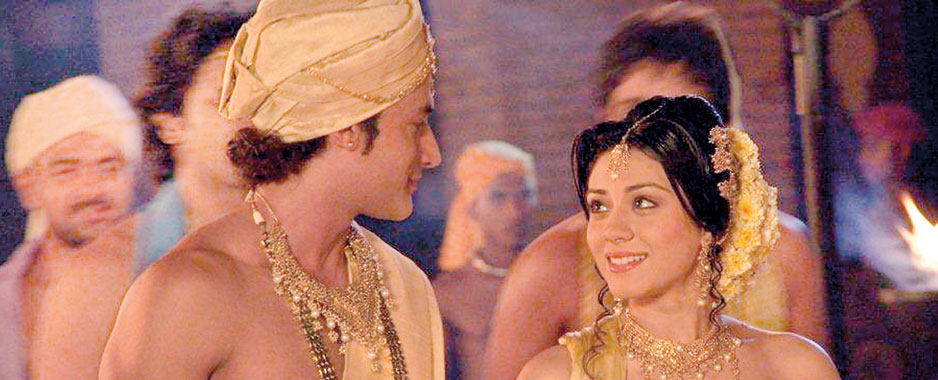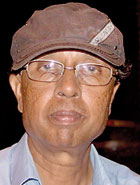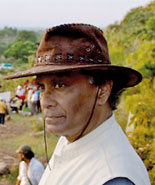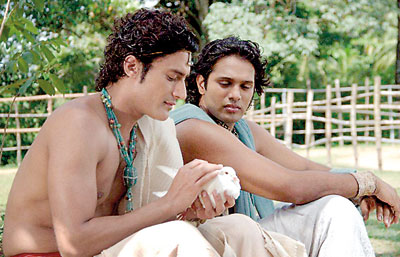Truly a gift to humanity
View(s):The recently released ‘ Sri Siddhartha Gautama’ marks a milestone in the annals of Sri Lankan cinema, says D.C. Ranatunga
My recollection of reading the Buddha Charitaya – the life of the Buddha goes back to my days in the early grades in school and the Daham Pasala – then commonly referred to as the ‘Sunday school’ because it was held on Sundays. Over the years we studied the Buddha’s life story in depth combining the narrative of how he spent his lay life and the teachings after Enlightenment.

The wedding scene: Prince Siddhartha (Gagan Malik) and Princess Yasodhara (Anchal Singh)
Watching the exceptionally high quality movie ‘Sri Siddhartha Gautama’ at its premiere last week, I went back to my schooldays, as Prince Siddhartha’s story unfolded in a most lucid manner, presented in a most sensitive way rarely seen in a film of this nature. Navin Gooneratne’s is a very bold effort. We heard about his keenness to do a film on the life of the Buddha to mark the Sambuddhatva Jayanthi. It did take a fairly long time but I was not surprised since I had observed his attention to detail in whatever he plans. I remember his effort when he embarked on setting up an arts centre at Pelawatte several years ago and how he worked with maestro Premasiri Khemadasa in producing one of the Master’s early musical creations. He always wanted to achieve the best. In ‘Sri Siddhartha Gautama’, he has achieved it.
‘ Sri Siddhartha Gautama’ the film has no religious bias. It provides superlative entertainment. The acting is superb. H.D. Dayananda’s photography is high class. Pradeep Ratnayake’s music is outstanding. All in all it’s a fine team effort.
It is a film all could relate to. Children will clearly remember the story of the early life of the Buddha. For the youth it gives a message. The adults are able to revisit what they have read and studied about Prince Siddhartha.
Navin Gooneratne had the blessing of the Maha Sangha and had got the advice and guidance of a number of reputed monks, two of whom- respected foreign monks resident in Sri Lanka – Ven Mettavihari and Ven Olande Ananda Thera – appear in the list of advisors. He has also obtained the advice of several consultants in different aspects of the production. Among them was the well-known filmmaker Chandran Ratnam, whose hand is quite visible in the film. He was the advisor to the producer and director. Saman Weeraman is the director. Edwin Ariyadasa, who incidentally takes a small role, had obviously helped to polish up the screenplay, particularly the Sinhala dialogue. Praveen Jayaratne’s editing is commendable.
Three well known figures Channa Wijewardana, Ravibandu Vidyapathi and Rangana Ariyadasa direct the choreography which is well executed and presented with none of those sequences dragging on.
And finally, hats off to those who did the casting which would obviously have been a challenge. Picking the right player for the right role obviously was the biggest challenge. The decision to look for Indian players –those who were not in the limelight – for some of the main roles was a bold move but one that has paid dividends. Gagan Malik and Anchal Singh who play Siddhartha and Yasodara excel in their acting.
He is handsome, she is pretty but their disciplined acting (I am told this was the first time ever they appeared in a film) is proof of the fine training they had received at Indian institutes of acting. Equally convincing is Gautam Gulati as Devadatta, who is always at loggerheads with Siddhartha in the film.
The Sri Lankan actors who appear in the key roles are seasoned players – Saranga Dissasekara (Channa), Roshan Ranawana (Nanda), Ranjan Ramanayake (King Suddhodana) and Buddhadasa Withanachchi (- guru Vishwamithra). I wish Prajapathi was a little more mature. The cameo by Wilson Gunarathne (Sage Asitha) of ‘Charitha Hathak’ fame, proves his ability to give life to a character be it on stage or screen.
The success of the film, in my view, is the presentation of the entire narrative in a rather restrained manner. There was ample opportunity to dramatise or romanticise the story but the production team has been most conscious of the need not to overplay situations. Siddhartha and Yasodhara’s wedding, for example, could have been one of pomp and grandeur but instead is presented in a solemn and dignified way. There were opportunities to drag the dance sequences. At the same time, the love and affection between the prince and the princess has been subtly portrayed.
It was rather disappointing that the final scene depicting Yasodhara’s reaction after Prince Siddhartha left her was condensed to half the size of the screen to accommodate the titles of the film. (These were hardly visible due to the size of the lettering). It also disturbed the fine rendition of verses from ‘Yasodaravata’ by Surali Fernando who, incidentally, hails from Los Angeles and was picked as the female singer in the film. Amarasiri Peiris’ was the male voice used. The one song he sang will long be remembered.
‘ Sri Siddhartha Gautama’ marks a milestone in the annals of Sri Lankan cinema. As the opening lines on the screen said, the epic movie is indeed ‘A gift to humanity’.
Unfolding the life of a son, husband and father
By Chandani Kirinde
Siddhartha Gautama was a restless soul. From the time of his birth till the age of 29, he lived a life filled with worldly pleasures showered on him in abundance by his father King Suddhodana in an effort to dissuade Siddhartha from becoming an ascetic as prophesied at the time of his birth. But in spite of being shielded from human suffering by creating an illusion that life was full of only pleasurable and good things, Siddhartha Gautama struggled with his inner self before deciding to undertake his quest to find a path to salvation from human suffering.
 Director Saman Weeraman |
 Producer Navin Gooneratne on the sets |
The newly released film, “Sri Siddhartha Gautama” explores in more detail the early life of Gautama Buddha who is caught between his yearnings to renounce his sheltered life within the walls of the Sakya Kingdom in northern India ruled by his father and faced with fulfilling his responsibilities as a son, a husband and a father. The movie begins with Siddhartha Gautama’s departure from his father’s palace under the cloak of darkness accompanied by his trusted lieutenant Channa and his faithful horse Kantaka. When they arrive at the bank of a river, Siddhartha hands over his princely garb and dons a simple robe, cuts off his rich locks of hair, bids farewell and begins his journey to find a path to salvation from human suffering. Initially he seeks guidance from several teachers but it is a self-discovered path that leads to his enlightenment.
While the life of Siddhartha Gautama from the time of his enlightenment is often the subject of films and documentaries, his life prior to his renouncing the life of a prince is not often looked at in detail, particularly the life he shared with his wife Yashodhara and his relationship with his father and other family members. “Sri Siddhartha Gautama” deals more with this aspect of the life of the “Enlightened One” starting with his birth at Lumbini, his mother Mahamaya’s death, his upbringing to be the future king of the Sakyans, a warrior clan known for their exploits in the battle field than for showing clemency towards their enemies. While his cousins and friends enthusiastically learn skills that would make them great warriors, Siddhartha undertakes these lessons halfheartedly, much to the alarm of his father. He pities a bird that has been shot down by an arrow and heals its wounds. ”A weakling,” his cousin Devadatta calls him.
The one time that Siddhartha feels a deep attachment and is overcome with love and longing is on meeting the princess Yasodhara. He has to complete with several suitors to win her hand by displaying his talents in archery and taming a wild horse which he does with ease. But even the deep love he feels for Yasodhara only briefly distracts him from his quest to find peace of mind which he is unable to do within the restricted life of the heavily fortified palace walls.
The turning point comes when he persuades his father to allow him to visit his subjects outside the palace gates which he had not been allowed to do freely by King Suddhodana. It is then that Siddhartha sees for himself what human suffering is. Old age, sickness, death, all sights kept out of his life hitherto, he comes face to face with. The meeting with a man in robes who has given up a life of attachment to embark on a journey to find salvation helps Siddhartha Gautama make up his mind to give up his life as a prince and undertake a similar journey. The wisdom which Siddhartha Gautama was born with is clearly shown in the movie. From his childhood, his destiny to become a great teacher is reflected by his words and actions. The tender moments he shares with Yasodhara, the fear that his feelings for his newborn son would bind him and weaken his resolve to leave the palace and the anguish he feels as he bids goodbye to his parents are all shown with sensitivity in the film.
Director Saman Weeraman has deviated from the more popularised story book tale of the life of Siddhartha Gautama to give a realistic view of the life of a man who became one of the greatest teachers the world has ever known. The movie is called a “Gift to humanity” but the true gift to humanity is the message of compassion and tolerance that was delivered by Gautama Buddha more than 2600 years ago. What artists can do by their creations is only refresh people’s minds about this message of Lord Buddha.
Sri Siddhartha Gautama is a presentation of the Light of Asia Foundation to commemorate the 2600 Sambuddhathva Jayanthiya.
Sensitively told, the story of an Indian prince
By Ayoma Wijesundere
A refreshing breath of air has blown across the Sinhala cinemascope with the introduction of Navin Gooneratne’s much awaited film – Siddhartha Gautama. It epitomises the basic teachings of the Buddha, compassion and kindness to all mankind, aversion to greed and discrimination, which we encounter in our everyday life. The message is very subtly radiated in the film by the actions of Prince Siddhartha.

Saving the life of a dove: Prince Siddhartha (Gagan Malik) with Nanda (Roshan Ranawana)
The film does not deal with complicated Buddhist philosophy but introduces to the onlooker a welcome story of an Indian Prince who gave up a luxurious life with all mundane challenges to find a path where mental stability and permanent peace of mind will prevail. It also gives a new dimension to the Buddhist controversy that he abandoned his wife and day-old son to seek Enlightment. We see a Siddhartha who is in conflict with his thoughts, attempting to please his father and at the same time rejecting the existing system. His bonding with Yasodhara is very comprehensive as they were partners in the line of Sansara. The story depicts an understanding but sorrowful Yasodhara who does not stand in her husband’s way in seeking the sublime truth.
The sets were absolutely authentic, reflecting an Indian Palace of a bygone era well over 2,500 years ago. The scene of Prince Siddhartha on his majestic white stallion leaving the Palace and cantering to the Neranjana river was very imaginative . The scenic beauty captured in the film of this area, the forest and the caves were breathtaking, which even the Himalayan mountains could never boast of. Ranjan Ramanayake plays a very impressive king Suddhodana. However Prajapati Gothami, misses out as a Mother figure as the years roll on. The role of Siddhartha acted by Indian film star Gagan was very emotional and brilliant.
It is a family film and a story that could be enjoyed without borders of race or religion. However if the film did have a lingering theme song as in “Angulimala” or “Surya Arana” it would have enhanced the production and captivated the audience to a higher degree. A Sinhala film (subtitled in English) of this calibre is rare today and is not to be missed.
Follow @timesonlinelk
comments powered by Disqus

















